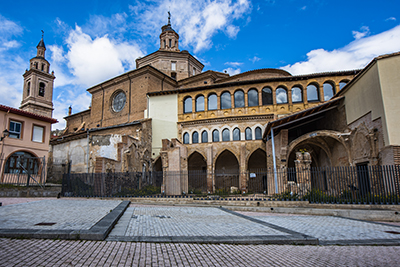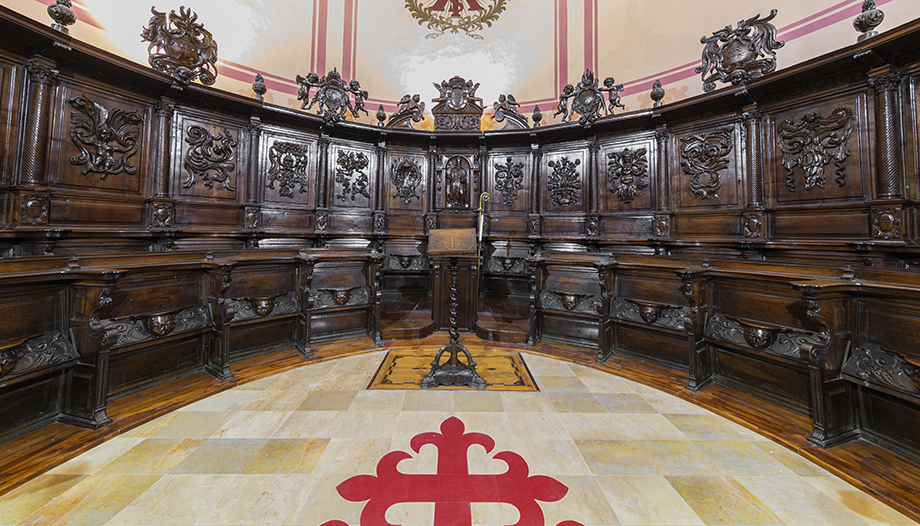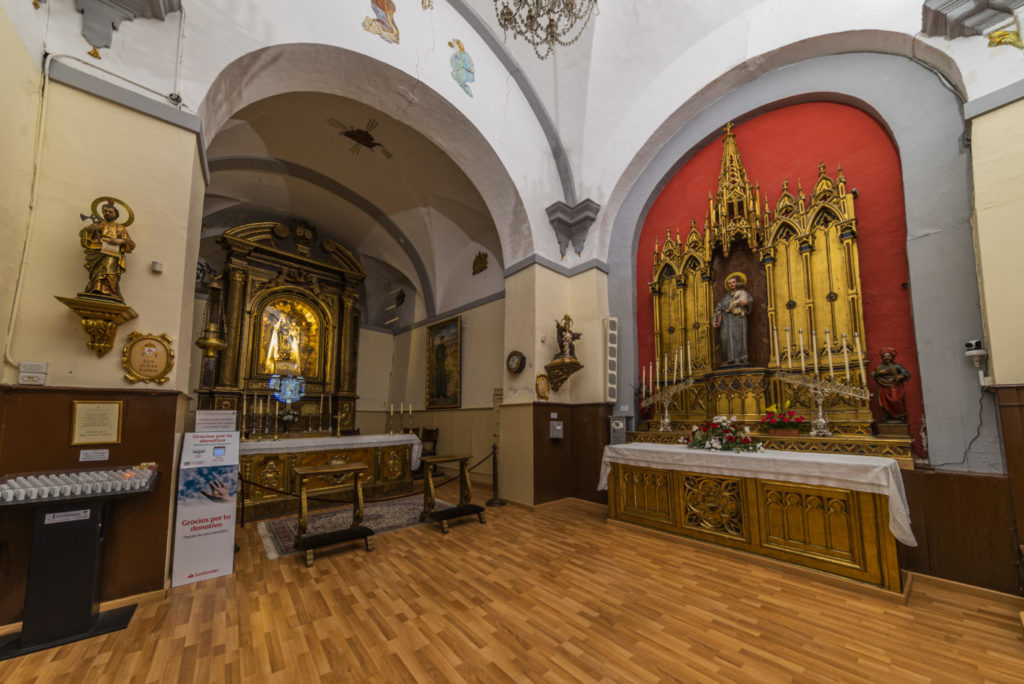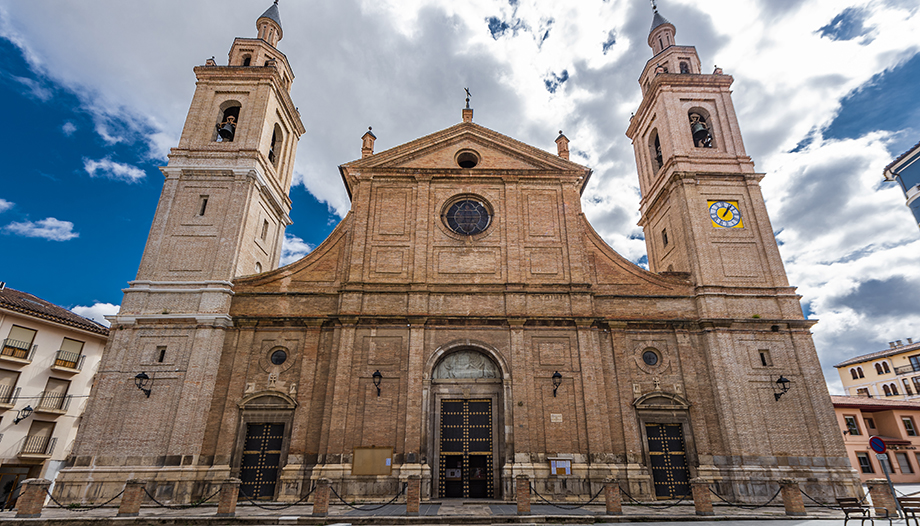The year 1099 of our era concluded the first Crusade in the Holy Land with the recovery of the Holy Sepulcher of Our Lord. Immediately, its liberator, Godfrey of Bouillon, had a chapter of canons constituted to take care of the cult of that temple, and a group of brave knights to guard it.
Forty years later, the new patriarch of Jerusalem sent one of his canons to Calatayud to take charge of the lands and goods granted to them by Count Berenguer IV as a consequence (and solution) of the inheritance that Alfonso I had left in favor of the three Jerusalemite orders. With these means, in 1156, a new temple was blessed in the Aragonese city, dedicated, like its mother house, to the Holy Sepulcher.
Gothic cloister and Herrerian temple
The remains of the Gothic-Mudejar church, which replaced the first Romanesque construction, are preserved in the remains of a beautiful cloister that, thanks to the restoration work of recent decades, can be visited and admired.
The present construction was erected between 1605 and 1613, promoted by the prior Juan de Palafox, and according to the plans of Gaspar de Villaverde, in the Herrerian style, with a large façade of three doors and flanked by two twin towers of quadrangular plan, joined to the central body by means of fins.

This Juan de Palafox, prior and patron of the collegiate church, should not be confused with his nephew, Blessed Juan de Palafox y Mendoza, who was viceroy of Mexico, bishop of Puebla and Osma, beatified in 2011 after many inconveniences, thanks to the tenacity of the Carmelite fathers who followed the cause for a historical and institutional friendship.
This second Juan de Palafox was the natural son of the Marquis of Ariza (who had a castle and urban palace in that town 30 km from Calatayud), brother of the prior. When the boy was nine years old, the marquis recognized him and, for his education, he pretended to entrust him to his uncle's custody. This one, with sensible logic, answered that a young clergyman with a natural nephew in his charge (the identity of the mother was always kept silent) would constitute a sure target for slander; and the child was put under the protection of the bishop of Tarazona, fray Diego de Yepes, who had been confessor of saint Teresa, and near the mother, who, repentant, was leading an exemplary and anonymous life in the Carmel of that city.
Lateral altarpieces
The most outstanding feature of this temple from the artistic point of view is, without a doubt, the set of altarpieces that are arranged on both sides of the main nave representing the Passion of the Lord. They were commissioned immediately after the completion of the building and paid for by the same prior Juan de Palafox. Later, in 1666, Canon Francisco Yago commissioned two more, which would be on either side of the main altar. The fact that all the side chapels are dedicated to the complete cycle of the passion and death of Jesus is unique in the world. Their quality separately, and especially as a whole, makes them a jewel of the Spanish baroque.
Choir
The choir, in the apse, hidden behind the main altar, has two orders of choir stalls carved in 1640, among which the prior's chair with a bas-relief of Saint Augustine, whose Rule was followed until the 19th century by the canons, stands out. In 1854, as a consequence of the disentailment, the chapter was extinguished, and the collegiate church was converted into a parish until, thanks to the efforts of the knights, Rome granted that, henceforth, it would be considered a collegiate church. ad honorem depending on the diocesan bishop, who would appoint the parish priest as prior of the chapter. This happened in 1901. In gratitude, the first parish priest-prior requested and obtained from Rome that the Spanish knights of the Holy Sepulchre could be invested as honorary canons: when they came to take possession, they occupied their respective places in the choir stalls.

Baldachin
On the main altar, in the 18th century, an imposing baldachin was erected that houses, behind the altar, the sculptural group of the Holy Burial with the recumbent Christ flanked by Nicodemus and Joseph of Arimathea. Above, it is topped with a dome ripped by skylights. At the top, some wood carvings, imitating white marble, of the triumphant Risen Christ and two angels carrying the holy sheet and the tombstone of the sepulcher.
Our Lady of Bolduc
On both sides of the transept there are two very capable chapels: in their time they were sacristy and chapter house. In the one on the Gospel side, there is, among other valuable objects, a 17th century canvas of the Virgin of Bolduc, brought from Brussels by the Gilman family, who were related in Calatayud to the Baron of Warsage and the De la Fuente family, and who are buried in the same chapel.
Virgin of Carmen (from Ruzola?)
On the Epistle side, which is larger, the old chapter house constitutes an annexed church-like area, with its own entrance at the back. It is today dedicated to the Virgin of Carmen, and used as the Chapel of the Blessed Sacrament. This Virgin was not always there, and its origin has not yet been completely clarified.
A little more than a year ago, by studying the Annals of the old convent of San Alberto of Discalced Carmelites of Calatayud (that I had just located in the city of Valencia), I read that, on the occasion of celebrating, in 1951, the centenary of the delivery of the scapular of the Virgin to St. Simon Stock, a triduum of acts of worship and popular piety had been organized in the city. On the last of those days, July 1, at seven o'clock in the evening, a "devout procession in which paraded all the most venerated images of the Queen and Mother of Carmel in the city, namely those of the churches of San Pedro de Carmelo, San Pedro de Carmelo, San Pedro de Carmelo, San Pedro de Carmelo, San Pedro de Carmelo, San Pedro de Carmelo and San Pedro de Carmelo: those of the churches of San Pedro de los Francos, San Juan el Real, Santa María, and that of the Holy Sepulcher -where the Brotherhood of Carmel is erected-, because this is the most venerated in Calatayud, due to the tradition that this image was the one that spoke to our father Ruzola".
All this requires an explanation. In the first place, in that chapel had its headquarters at that time, the Third Order and Brotherhood of Carmen, which explains why the bilbilitanos who wanted to receive the scapular went there and why the Carmelites felt it as something very much theirs. In 1955, when the nuns harbored the hope that there would be again friars of their order in the city, in one of their festivities, they recited some verses in which they said: "Do not touch the noble Bílbilis, / which is all Carmelite; / three temples has raised / its so cherished piety: / el Sepulcro, las Descalzas, / y este futuro Carmelo, / que de la Estación se llama" (next to the train station, a family owned a small hermitage that they offered to the friars to found a convent; these, after studying the matter, refused to found for lack of subjects, but they came regularly from Zaragoza to celebrate Mass every Sunday).
But let us come to the venerable Ruzola. He was born in Calatayud in 1559. Orphan of father, he was taken in by his maternal uncle who was prior in the already disappeared convent of Carmen (footwear), which stood in front of the collegiate church of the Holy Sepulchre. Seeing the many qualities of the little one, the provincial took him with him to Saragossa; but this one, inspired by the Virgin, decided to go to the discalced. In this condition, Domingo de Jesús María, as he would be called from now on, first studied, and then held posts in Valencia, Pastrana, Madrid, Alcalá, Barcelona, Zaragoza, Toledo, Calatayud... and then went to Rome, where he contributed to the creation of a Congregation of Discalced Carmelites separated from that of Spain, of which he was elected general. He carried out diplomatic missions in various countries of Europe; he had a decisive intervention with his harangues and prayers in the victory of the Catholics in the battle of the White Mountain at the gates of Prague. His death came in 1630 in Vienna, in the palace of Emperor Ferdinand II, where the monarch had obliged him to stay as papal legate. Solemn funerals were held in the capital of the Empire, attended by all the nobility. In Calatayud, meanwhile, there was no news of his person, much less of his wanderings. Thanks to a letter sent by the Emperor to the City Council of the city, the municipality dedicated a lucid funeral to him a year after his death in the church of San Juan de Vallupié. Later (1670), by cession of his relatives, the house where he was born, in the Plaza del Olivo, was transformed into a chapel dedicated to Nuestra Señora del Buen Parto, which remains open for worship to this day.
Known in his time as the "thaumaturge" for his many miracles, his process of canonization was initiated shortly after his death by the Emperor himself, and resumed, after a long hiatus, by the Carmelites in the early twentieth century, and has been at a standstill since 1940 waiting for someone to take charge of it.
His biographers agree in narrating that, while he was in the convent of Carmen under the protection of the uncle prior, he gave great signs of piety; and at night, frequently, he would go to a chapel where there was a sculpture of the Virgin and a carving of the Crucified with whom he would talk. The Virgin sometimes left the Child in his hands. According to the Glories of CalatayudFor many years afterwards, this Child was brought to the sick, who obtained through him corporal or spiritual graces. These conversations of little Dominic with Jesus and Mary, which are recounted in various stories, are depicted live on an ancient canvas in the chapel of the Plaza del Olivo. The convent of Carmen was demolished in 1835, and its most precious jewels were distributed. It is known where the tabernacle went, and a monstrance...; and, above all, the miraculous Christ, which was given to the convent of Capuchin nuns, where it is venerated by the people of Bilbilitano. But, of the Virgin that granted little Dominic similar favors as the Christ, there is no news of where it ended up. According to a tradition, which Carlos de la Fuente and Rafael López-Melús have collected (and which was echoed by the Annals of the Carmelites in 1951), that image is the one that is now venerated in the collegiate-basilica of the Holy Sepulchre. Many other bilbilitanos remember having heard from their elders that the Virgin of Carmen passed to the Holy Sepulchre of the palace of the Marquises of Villa Antonia.
Both traditions are reconcilable. The so-called palace of Villa Antonia stands opposite the site occupied by the convent of El Carmen: only a narrow street separates them. Perhaps, the friars moved the image from the convent to the palace looking for a safer place for it than the collegiate church that had recently been sacked by the French and feared its forthcoming disentailment. The marquises would cede it in more propitious times to the Holy Sepulchre, where it was probably originally destined. In fact, in that stately home the image did not fit: too large for the private oratory, it would be placed somewhere worthy, but inappropriate for its size. Neither in the collegiate church, when it was moved to this temple, was there room for it. In fact, it was installed in a chapel that was dedicated to the Virgin of Guadalupe, superimposing them: the canvas of the Virgin of Guadalupe was practically covered by the lump of Our Lady of Mount Carmel, a dressed statue. The representation of the Guadalupana had been donated by Canon Doctor Tomas Cuber, who had gone to Mexico in 1775 as an inquisitor. Thanks to some photographs provided to me by the lady Isabel Ibarra, historian, the reader will be able to see the two images overlapping, and then separated, as when they take the image of Carmen, for her novena, to the central nave.

If the last inhabitant of the palace were alive, we would have no doubts about the steps the image took. She had a privileged memory for the things of her house. I met her when I was about twenty years old, and she was the grandmother of the friends who had introduced me to her house. They lived regularly in Madrid, and came to Calatayud in summer. I don't know how the strange layout of the entrance to the house came up in conversation one day. In the reforms carried out in the nineteenth century, a facade had been erected to the Plaza del Carmen very well laid out, with a large doorway crowned with a heraldic coat of arms. However, upon entering the entrance hall, the staircase, a bit like a service staircase, and the access to a small vestibule caused surprise. From there, through a corridor, one finally reached the expected succession of spacious and stately rooms. The Marquise explained to me that the house used to be entered from Carmen Street and the main floor was reached by climbing a wide staircase. But in the time of her grandparents, on that staircase were indelible traces of a crime of passion between servants of the house. That was the reason to close that access and open a new one. With this memory and interest in the things of her family, how could she not explain the origin of the Virgin of Carmen! The descendants of the Marquise only remember that in her house the trousseau of the Virgin was kept, and that they came from the collegiate church to look for it every time it was a big feast or the Virgin was taken out in procession. It is also popular memory that until the 70s of the last century, the Virgin, when in procession, made station in the palace, and entered the courtyard, as a former guest of the house. The proximity of the palace and the collegiate church was not only physical. The palace, now abandoned, had been built and inhabited for centuries by the old lineage of the Muñoz-Serrano family - the maternal surname of the marquise I knew, Doña Antonia de Velasco - who were buried at the foot of the presbytery of the Holy Sepulchre of Calatayud.
I have shared all this information with some people who have researched about the Order and this ancient collegiate church, and so far neither they nor I have found a document that allows us to say with certainty that the image of the Virgin of Mount Carmel with Child that is venerated in the Santo Sepulcro of Calatayud is the same one with which the little Domingo Ruzola held mystical conversations in the convent of Carmen, on the border of the collegiate church. To the inconvenience that De la Fuente himself observes -and it is notorious- that the workmanship of the one now venerated seems to be later, it can be objected that perhaps it is a restoration and adaptation to the taste of the 19th century, as happens with so many retouched images. Finally, I do not lose hope that the research that continues to be done in the archives, or a careful examination of the image, will end up providing us with the solution to this hypothesis, or will bring us new surprises.
*The photos in this article are property of the Torre Albarrana Association.








